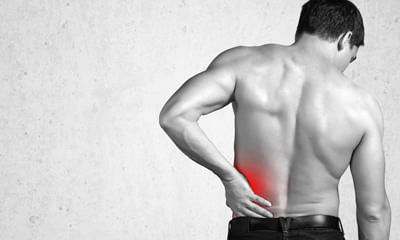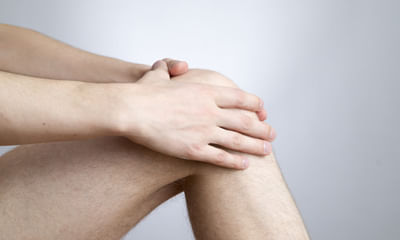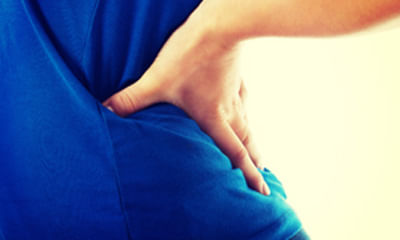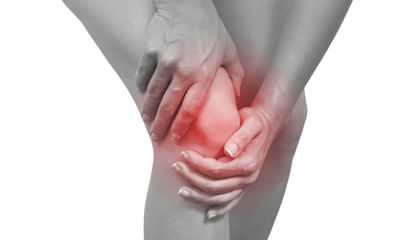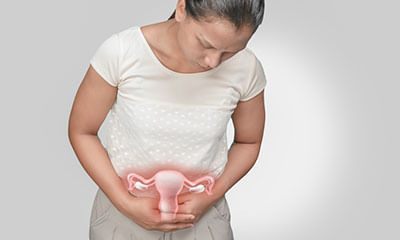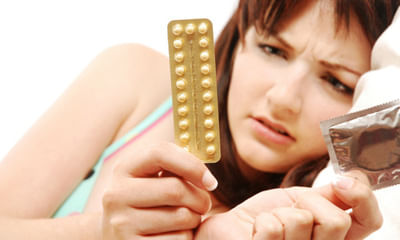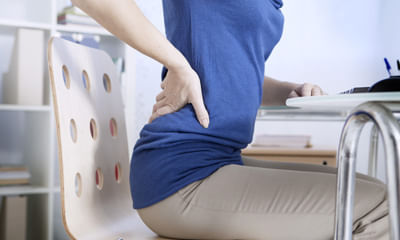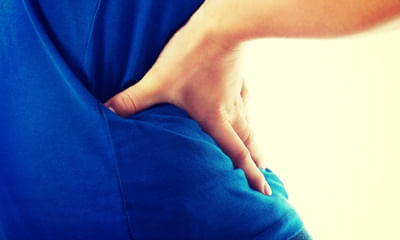Hand And Leg Pain During Pregnancy
I have pain in lower back, butt, legs and feet. And also burning sensation in the legs and feet. And I am not able to wa ...
Ask Free Question
If you are suffering from burning pain or tingling sensation in hands or feet; sharp shooting pain in legs; numbness in hands or feet, then you might be suffering from neuropathic pain. What is a neuropathic pain? Neuropathic pain is a special type of pain which occurs when there is damage to nerve fibres, which produces tingling or burning type of pain. It is of two types: 1. Peripheral neuropathic pain: it occurs when there is an injury to peripheral nerve fibres (a-delta or c-fibers) which carries pain sensation to the brain (thalamus) for interpretation. 2. Central neuropathic pain: it occurs due to sensitization of central pain interpreting mechanisms (thalamus) to falsely feel pain when peripheral nerve fibres are no longer sending pain impulses to them. Worldwide-estimates of the prevalence of neuropathic pain is 7% i.e. 7 persons out of 100 people are suffering from different types of neuropathic pain. Symptoms: •tingling sensation or feeling of ants crawling under skin •burning sensation •sharp shooting pain or electric current-like sensation •stabbing pain •dull pain with numbness or heaviness reasons for neuropathic pain: •diabetes mellitus: most common cause worldwide due to uncontrolled blood sugar levels, causing damage to nerve fibres. •alcohol consumption/cigarette smoking: damage to nerve fibres or damage to blood vessels supplying nerve fibres. Burning pain in feet •neck pain/low back pain/glutei pain •vit. B12 deficiency •chemotherapy for cancer patients •post-herpes virus infection •post-spine surgery •post-amputation •diseases like spinal cord injury, multiple sclerosis, hiv, lead toxicity, etc. Special neuropathies: 1. Carpal tunnel syndrome: tingling, burning sensation in hand which occurs due to compression of median nerve in the wrist area. It occurs in women especially due to pregnancy, hypothyroidism, diabetes, etc. And in men due to improper position of the wrist during working on computers. 2. Cervical radiculopathy: pain in neck and shoulder region (which increases with neck movements), along with sharpshooting pain radiating from neck to hand occurs in cases of cervical radiculopathy. This is due to compression of the cervical nerve root by disc prolapse, facet subluxation, muscle spasm, trauma, etc. 3. Lumbar radiculopathy: pain in lower back or glutei region with sharp shooting pain radiating from hip to leg/foot region, occurs in cases of lumbar radiculopathy or sciatica. This is due to compression of lumbar nerve root or sciatic nerve by disc prolapse, facet joint, trauma, hypertrophied ligamentumflavum, piriformis syndrome, etc. 4. Meralgiaparesthetica: tingling or burning sensation in front of the thigh, occurs due to compression of lateral cutaneous nerve of thigh, near waist region. Usual causes are tight or constrictive clothing at waist region, prolonged sitting, protuberant abdomen, etc. Prevention of neuropathy: 1. Avoid alcohol consumption and cigarette smoking. 2. Maintain ideal body weight/bmi (body mass index) 3. Lifestyle changes: daily exercises (>30 minutes per day) or brisk walking or swimming; avoid prolonged sitting or standing (>30 minutes). 4. Food/diet should have following components: •green vegetables e.g. Spinach, fenugreek leaves (methi), radish, etc •coloured vegetables e.g. Tomato, carrot, capsicum (green/red), ladies-finger (bhindi) •milk products e.g. Milk, buttermilk, curd, cheese (paneer) •protein-rich foods e.g. Fish, egg, chicken, pulses (daal) •fibre-rich foods e.g. Bran, oats, brown-rice •fruits e.g. Apple, orange, guava, papaya, pomegranate, berries 5. Blood sugar control (in diabetics) 6. Care of feet: •regular inspection of feet (with mirror) •comfortable, well-fitted shoes •regular consultation with a podiatrist •treatment of wounds, foot deformities 7. Adequate sleep 8. Warm water bath (increases blood flow to the affected area) treatment: •consult pain medicine specialist. •neuropathic painkillers e.g. Amitriptyline, pregabalin, gabapentin, capsaicin, duloxetine, etc. •vit. B12 supplements, anti-oxidants, multi-vitamins. •transcutaneous electrical nerve stimulation (tens) •acupuncture •relaxation and yoga •neural prolotherapy.
I'm 24 years male. I'm having pain in foot for around an year but have ignored but it was still there. It is kind of bur ...
Ask Free Question
Burning pain or tingling sensation in hands or feet if you are suffering from burning pain or tingling sensation in hands or feet; sharp shooting pain in legs; numbness in hands or feet, then you might be suffering from neuropathic pain what is a neuropathic pain? Neuropathic pain is a special type of pain which occurs when there is damage to nerve fibres, which produces tingling or burning type of pain. It is of two types: 1. Peripheral neuropathic pain: it occurs when there is an injury to peripheral nerve fibres (a-delta or c-fibers) which carries pain sensation to the brain (thalamus) for interpretation. 2. Central neuropathic pain: it occurs due to sensitization of central pain interpreting mechanisms (thalamus) to falsely feel pain when peripheral nerve fibres are no longer sending pain impulses to them. Worldwide-estimates of the prevalence of neuropathic pain is 7% i.e. 7 persons out of 100 people are suffering from different types of neuropathic pain. Symptoms: •tingling sensation or feeling of ants crawling under skin •burning sensation •sharp shooting pain or electric current-like sensation •stabbing pain •dull pain with numbness or heaviness reasons for neuropathic pain: •diabetes mellitus: most common cause worldwide due to uncontrolled blood sugar levels, causing damage to nerve fibres. •alcohol consumption/cigarette smoking: damage to nerve fibres or damage to blood vessels supplying nerve fibres. Burning pain in feet •neck pain/low back pain/glutei pain •vit. B12 deficiency •chemotherapy for cancer patients •post-herpes virus infection •post-spine surgery •post-amputation •diseases like spinal cord injury, multiple sclerosis, hiv, lead toxicity, etc. Special neuropathies: 1. Carpal tunnel syndrome: tingling, burning sensation in hand which occurs due to compression of median nerve in the wrist area. It occurs in women especially due to pregnancy, hypothyroidism, diabetes, etc. And in men due to improper position of the wrist during working on computers. 2. Cervical radiculopathy: pain in neck and shoulder region (which increases with neck movements), along with sharpshooting pain radiating from neck to hand occurs in cases of cervical radiculopathy. This is due to compression of the cervical nerve root by disc prolapse, facet subluxation, muscle spasm, trauma, etc. 3. Lumbar radiculopathy: pain in lower back or glutei region with sharp shooting pain radiating from hip to leg/foot region, occurs in cases of lumbar radiculopathy or sciatica. This is due to compression of lumbar nerve root or sciatic nerve by disc prolapse, facet joint, trauma, hypertrophied ligamentumflavum, piriformis syndrome, etc. 4. Meralgiaparesthetica: tingling or burning sensation in front of the thigh, occurs due to compression of lateral cutaneous nerve of thigh, near waist region. Usual causes are tight or constrictive clothing at waist region, prolonged sitting, protuberant abdomen, etc. Prevention of neuropathy: 1. Avoid alcohol consumption and cigarette smoking. 2. Maintain ideal body weight/bmi (body mass index) 3. Lifestyle changes: daily exercises (>30 minutes per day) or brisk walking or swimming; avoid prolonged sitting or standing (>30 minutes). 4. Food/diet should have following components: •green vegetables e.g. Spinach, fenugreek leaves (methi), radish, etc •coloured vegetables e.g. Tomato, carrot, capsicum (green/red), ladies-finger (bhindi) •milk products e.g. Milk, buttermilk, curd, cheese (paneer) •protein-rich foods e.g. Fish, egg, chicken, pulses (daal) •fibre-rich foods e.g. Bran, oats, brown-rice •fruits e.g. Apple, orange, guava, papaya, pomegranate, berries 5. Blood sugar control (in diabetics) 6. Care of feet: •regular inspection of feet (with mirror) •comfortable, well-fitted shoes •regular consultation with a podiatrist •treatment of wounds, foot deformities 7. Adequate sleep 8. Warm water bath (increases blood flow to the affected area) treatment: •consult pain medicine specialist. •neuropathic painkillers e.g. Amitriptyline, pregabalin, gabapentin, capsaicin, duloxetine, etc. •vit. B12 supplements, anti-oxidants, multi-vitamins. •transcutaneous electrical nerve stimulation (tens) •acupuncture •relaxation and yoga •neural prolotherapy.
I'm 24 years male. I'm having pain in foot for around an year but have ignored but it was still there. It is kind of bur ...
Ask Free Question
Burning pain or tingling sensation in hands or feet if you are suffering from burning pain or tingling sensation in hands or feet; sharp shooting pain in legs; numbness in hands or feet, then you might be suffering from neuropathic pain what is a neuropathic pain? Neuropathic pain is a special type of pain which occurs when there is damage to nerve fibres, which produces tingling or burning type of pain. It is of two types: 1. Peripheral neuropathic pain: it occurs when there is an injury to peripheral nerve fibres (a-delta or c-fibers) which carries pain sensation to the brain (thalamus) for interpretation. 2. Central neuropathic pain: it occurs due to sensitization of central pain interpreting mechanisms (thalamus) to falsely feel pain when peripheral nerve fibres are no longer sending pain impulses to them. Worldwide-estimates of the prevalence of neuropathic pain is 7% i.e. 7 persons out of 100 people are suffering from different types of neuropathic pain. Symptoms: •tingling sensation or feeling of ants crawling under skin •burning sensation •sharp shooting pain or electric current-like sensation •stabbing pain •dull pain with numbness or heaviness reasons for neuropathic pain: •diabetes mellitus: most common cause worldwide due to uncontrolled blood sugar levels, causing damage to nerve fibres. •alcohol consumption/cigarette smoking: damage to nerve fibres or damage to blood vessels supplying nerve fibres. Burning pain in feet •neck pain/low back pain/glutei pain •vit. B12 deficiency •chemotherapy for cancer patients •post-herpes virus infection •post-spine surgery •post-amputation •diseases like spinal cord injury, multiple sclerosis, hiv, lead toxicity, etc. Special neuropathies: 1. Carpal tunnel syndrome: tingling, burning sensation in hand which occurs due to compression of median nerve in the wrist area. It occurs in women especially due to pregnancy, hypothyroidism, diabetes, etc. And in men due to improper position of the wrist during working on computers. 2. Cervical radiculopathy: pain in neck and shoulder region (which increases with neck movements), along with sharpshooting pain radiating from neck to hand occurs in cases of cervical radiculopathy. This is due to compression of the cervical nerve root by disc prolapse, facet subluxation, muscle spasm, trauma, etc. 3. Lumbar radiculopathy: pain in lower back or glutei region with sharp shooting pain radiating from hip to leg/foot region, occurs in cases of lumbar radiculopathy or sciatica. This is due to compression of lumbar nerve root or sciatic nerve by disc prolapse, facet joint, trauma, hypertrophied ligamentumflavum, piriformis syndrome, etc. 4. Meralgiaparesthetica: tingling or burning sensation in front of the thigh, occurs due to compression of lateral cutaneous nerve of thigh, near waist region. Usual causes are tight or constrictive clothing at waist region, prolonged sitting, protuberant abdomen, etc. Prevention of neuropathy: 1. Avoid alcohol consumption and cigarette smoking. 2. Maintain ideal body weight/bmi (body mass index) 3. Lifestyle changes: daily exercises (>30 minutes per day) or brisk walking or swimming; avoid prolonged sitting or standing (>30 minutes). 4. Food/diet should have following components: •green vegetables e.g. Spinach, fenugreek leaves (methi), radish, etc •coloured vegetables e.g. Tomato, carrot, capsicum (green/red), ladies-finger (bhindi) •milk products e.g. Milk, buttermilk, curd, cheese (paneer) •protein-rich foods e.g. Fish, egg, chicken, pulses (daal) •fibre-rich foods e.g. Bran, oats, brown-rice •fruits e.g. Apple, orange, guava, papaya, pomegranate, berries 5. Blood sugar control (in diabetics) 6. Care of feet: •regular inspection of feet (with mirror) •comfortable, well-fitted shoes •regular consultation with a podiatrist •treatment of wounds, foot deformities 7. Adequate sleep 8. Warm water bath (increases blood flow to the affected area) treatment: •consult pain medicine specialist. •neuropathic painkillers e.g. Amitriptyline, pregabalin, gabapentin, capsaicin, duloxetine, etc. •vit. B12 supplements, anti-oxidants, multi-vitamins. •transcutaneous electrical nerve stimulation (tens) •acupuncture •relaxation and yoga •neural prolotherapy.
I have pain and burning below knees, ankles. Some ankles bone over growth. Seeking your advice and treatment. ...
Ask Free Question
Skeletal dysplasia a category of rare genetic disorders that affect bones and joints and hinder children's growth and development. The disorder causes abnormally shaped bones, especially in the head, spine and long bones of the arms and legs. About half of fetuses with skeletal dysplasia are stillborn or die within the first six weeks of life. But not all children with dysplasias have severe medical problems. Many of these children can live relatively normal lives the first indication that a baby has a skeletal dysplasia condition may arise during a routine prenatal ultrasound examination, usually one conducted in the second trimester of pregnancy. The image may show arms and legs shorter than average and a head larger than average. Developmental dysplasia of the hip doesn't cause pain in babies, so can be hard to notice. Doctors check the hips of all newborns and babies during well-child exams to look for signs of ddh. Parents could notice: the baby's hips make a popping or clicking that is heard or felt. Stretching and strengthening exercises or use of specialized devices may provide symptom relief. These include: physical therapy. A physical therapist can instruct you in a series of exercises to stretch the plantar fascia and achilles tendon and to strengthen lower leg muscles, which stabilize your ankle and heel. A therapist might also teach you to apply athletic taping to support the bottom of your foot. Night splints. Your physical therapist or doctor might recommend that you wear a splint that stretches your calf and the arch of your foot while you sleep. This holds the plantar fascia and achilles tendon in a lengthened position overnight and facilitates stretching. Orthotics. Your doctor might prescribe off-the-shelf or custom-fitted arch supports (orthotics) to help distribute pressure to your feet more evenly. Injections. Injecting a type of steroid medication into the tender area can provide temporary pain relief. Multiple injections aren't recommended because they can weaken your plantar fascia and possibly cause it to rupture. More recently, platelet-rich plasma has been used, under ultrasound guidance, to provide pain relief with less risk of tissue rupture. Lifestyle and home remediesto reduce the pain of plantar fasciitis, try these self-care tips: maintain a healthy weight. Lose weight if you're overweight or obese to minimize stress on your plantar fascia. Choose supportive shoes. Avoid high heels. Buy shoes with a low to moderate heel, good arch support and shock absorbency. Don't go barefoot, especially on hard surfaces. Don't wear worn-out athletic shoes. Replace your old athletic shoes before they stop supporting and cushioning your feet. If you're a runner, buy new shoes after about 400 to 500 miles of use. Change your sport. Try a low-impact sport, such as swimming or bicycling, instead of walking or jogging. Apply ice. Hold a cloth-covered ice pack over the area of pain for 15 to 20 minutes three or four times a day or after activity. Or try ice massage. Freeze a water-filled paper cup and roll it over the site of discomfort for about five to seven minutes. Regular ice massage can help reduce pain and inflammation. Stretch your arches. Simple home exercises can stretch your plantar fascia, achilles tendon and calf muscles. Heel pain prevention: maintain a healthy weight. Choose supportive shoes. Don't wear worn-out shoes. Apply ice. Ice. Use an ice pack or cold compress on your foot for 10 to 15 minutes at a time. This is especially beneficial at the end of a long day or when you’ve spent a lot of time on your feet. Or, roll a frozen water bottle under your foot. This method incorporates a bit of massage, relieving tightness in the bottom of your foot. Massage. Massaging the arch of your foot helps to relieve pain and promote mobility. Use your fingers and knuckles to deeply massage your foot for 1 to 5 minutes at a time. One technique is to place both thumbs at the center line of your arch and move them to the outer edges of your feet. Inserts. Use cushion inserts in your shoes for additional support and cushioning. Inexpensive options can be purchased off the shelf. Wear supportive shoes with thicker soles and extra cushioning for additional support that can help to reduce tension in the plantar fascia. Kinesiology tape can be used to improve arch and heel support. Night splints. Many people find quick and effective results by using night splints. They can be worn while sleeping to stretch the plantar fascia. They help to keep the plantar fascia relaxed and prevent you from pointing your feet down. Exercisefoot flexuse your hand to pull your toes back toward your shin. Hold this position for about 30 seconds. Do each side two to three times. Toe towel grab place a small towel under your foot. Curl your toes to grip the towel. Raise the front of your foot off the floor. Hold this position for a few seconds. Release the towel as you lift up your toes and spread them as far apart as possible. Heel and calf stretch to do this stretch: 1.stand facing a wall. 2.place your hands on the wall and move one foot back as far as you can comfortably. Toes on both feet should be facing forward, heels flat, with a slight bend in your knees. 3.lean into the stretch and hold for 30 seconds. You should feel the stretch in your back leg. 4.change legs and repeat. 5.do this stretch twice for both legs. Golf ball roll roll a golf baell under your right foot. Continue for up to 1 minute. Do each foot two to three times.
Hello doc. I have pcos and was put on krimson 35 for 1st time on 14th feb (7 days after last period- mid cycle) and I to ...
Ask Free Question
As you said, this could be either. There is not much that can be done right now. Wait for one week or 10 days. If periods have still not come, do a urine pregnancy test.
Hello doctor, me and my gf having intimate moments during that time I fingering her their may be precum on my hand when ...
Ask Free Question
From your description as such there were no chances of pregnancy, and that is confirmed by withdrawal bleeding. After taking the high hormonal emergency pill like unwanted 72 one gets withdrawal bleeding 5 to 10 days later, and then a new cycle starts means new counting from from bleeding.
I am 28 years female and I am suffering from back pain should I plan for pregnancy? Please help me. ...
Ask Free Question
Because your kidneys are located toward your back and underneath your ribcage, it may be hard to tell if the pain you’re experiencing in that area is coming from your back or your kidney. The symptoms you’re having can help you figure out which is the source of the pain. The location, type, and severity of the pain are some of the things that will be different depending on whether the pain is from a problem in your kidneys or your back. How to identify kidney painkidney pain is most often caused by a kidney infection or a stone in the tubes coming out of your kidney. If the pain is coming from your kidney, it will have these features: where the pain is located kidney pain is felt in your flank, which is the area on either side of your spine between the bottom of your ribcage and your hips. It usually occurs in one side of your body, but it can occur in both sides. Type of pain kidney pain is usually sharp if you have a kidney stone and a dull ache if you have an infection. Most often it will be constant. It won’t get worse with movement or go away by itself without treatment. If you’re passing a kidney stone, the pain may fluctuate as the stone moves. Radiation of the pain sometimes the pain spreads (radiates) to your inner thigh or lower abdomen. Severity of the pain kidney pain is classified according to how bad it is — severe or mild. A kidney stone usually causes severe pain, and the pain from an infection is usually mild. Things that make it better or worse typically, nothing makes the pain better until the problem is corrected, such as by passing the stone. Unlike back pain, it usually won’t change with movement. Accompanying symptoms if you have a kidney infection or a kidney stone, you may also experience: •fever and chills •nausea and vomiting •cloudy or dark urine •an urgent need to urinate •pain when you urinate •a recent infection in your bladder •blood in your urine (this can happen with an infection or kidney stones) •small kidney stones that look like gravel in your urine how to identify back pain back pain is more common than kidney pain and is usually caused by a problem in the muscles, bones, or nerves in your back. Has the following features: where the pain is located back pain can occur anywhere on your back, but it’s most commonly located in your lower back or one of your buttocks. Type of pain muscle pain feels like a dull ache. If a nerve has been injured or irritated, the pain is a sharp burning sensation that may travel down your buttock to your lower leg or even your foot. Muscle pain may affect one or both sides, but nerve pain usually only affects one side. Radiation of the pain nerve pain may spread to your lower leg. Pain from a muscle usually stays in the back. Severity of the pain back pain is described as acute or chronic based on how long you’ve had it. Acute pain lasts days to weeks, subacute pain lasts six weeks to three months, and chronic pain lasts longer than three months. Things that make it better or worse back pain may get worse with movement or if you sit or stand for a long time. It may get better if you switch positions or walk around. Accompanying symptoms other symptoms you may experience with back pain include: •the painful spot looking swollen and feeling tender to the touch •a muscle spasm in the painful area •numbness or weakness in one or both of your legs (if the pain is due to a nerve issue) if you find you have back pain and can’t hold your urine or bowel movements, something is pressing on your spinal nerves, and you should be evaluated immediately. This condition, called cauda equina syndrome, can cause severe long-term damage to your spinal nerves if not treated right away. 6 imbalances that cause pain—and how to fix them "pain is a medical condition and a medical issue, says brett jones, owner of applied strength in pittsburgh who is certified for the functional movement screen, a system of tests and cor rective exercise strategies. "it's a warning sign. The pain is there to tell you something's wrong. And that warning sign could be more serious than "you're going too hard. Jones and the other coaches consulted for this piece all had a horror story to tell-when pain in a client meant a more serious condition such as a nerve issue, thyroid issue, or even cancer. The point: if you experience regular pain while exercising-or when you're not-go to the doctor. If you've been cleared by a doc and you're still feeling discomfort, try these simple tests to see what's truly causing the pain-it could be related to an imbalance in a completely different part of your body. The good news: with these drills, stretches, and corrective exercises, you may be able to fix them-no doctors necessary. Neck pain and headaches? Could be your shoulders. If you're experiencing these symptoms and have been cleared by a doctor, check out the height of your shoulders, says aaron brooks, a biomechanics expert and owner of perfect postures in auburndale, ma. "look in the mirror and see if one shoulder is higher or lower than the other, he says. If one of your shoulders is higher than the other, you'll be strengthening one more than the other, and it may wind up pulled forward more than the other-resulting an inward rotation of that hand. "when you do a row or a press, that side's going to get pinched. There's less room in the shoulder. You can wind up with bursitis or tendonitis. Or headaches and neck pain. Fix it: if the mirror test shows they're uneven, try this single-arm doorway stretch, brooks says. To do it, stand inside the threshold of a door, and place your right forearm inside the door on the right side of the jamb, palm against the jamb at about shoulder height. In this position, twist your chest slightly through the door to stretch your chest-alternately, you can take a step forward with your right foot, keeping your left foot in the threshold. This stretch will open your chest muscles and create room in your shoulder for movement. Pair that stretch with this mid-back strengthening exercise: grab a resistance band and stretch it in front of your chest so that your arms are straight out to the sides from your shoulders, palms facing up. At the full extension of your arms, the band should be stretched out. Return to clap your hands in front, and repeat the movement. Pair these two moves-in this order-three times per week. Shoulders even? Your headaches could be from a forward-leaning head. If you don't see an imbalance in the height of your shoulders, turn to the side, says robert taylor, owner of smarter team training in baltimore. If your head is jutting far forward of your shoulders, it could ultimately decrease the amount of blood flow to your head and neck. "the head leans forward, the spine leans forward, and it puts unnecessary stress on the lower spine too, he says. With the decreased blood flow to your thinking cap, you could get headaches. Fix it: increase blood flow up top and return your head to its natural, up-tall position by strength training your neck, taylor says. Try this one-arm shrug to even things out: sit on an upright bench, like one you'd use for a shoulder press. Holding a dumbbell in your right hand, place your left hand under your left butt cheek and grab the side of the seat. Let your right hand hang down straight by your side and pull your shoulder blades back and together. Now raise your right shoulder up towards your ear-raise it straight up instead of rolling your shoulder. Hold for a beat at the top, and then return to the start position. Complete a set of 10, and repeat on the other side. Knee pain when you run? Could be your hips. "the knee has two bad neighbors-the hip and the ankle, jones says. The pain you feel in your knee could very well be tightness or immobility in those bad neighbors. "they sweep all their leaves into the knee's yard. Everyone blames the knee, but it's the neighbors. To see if your hips have a proper level of mobility, lay on your back in a doorway so that the middle of your kneecap is right on the threshold. Relax your arms at your sides, palms up. Bring your feet together, toes pointed at the ceiling. Pull your toes towards your shins to create a 90-degree angle at the ankle. Keep one leg straight and still as you slowly raise the other leg until either your knee bends on your raising leg, or your bottom foot bends or turns out to the side. "see if the knobby part of your ankle can make it past the door frame, jones says. If it does, your hips are plenty mobile-check the ankle test below to see if that's causing some knee issues. If either ankle can't make it, foam roll your hips and glutes, and then work on this stretch using a belt or strap for instant improvement. Fix it: lying in the same position as during the test, wrap a strap or belt around one foot and raise it until you just start to feel a stretch-not to the level where it's all the stretch you can take, but just the beginning of the stretch, jones says. Once here, bring your other leg up to meet it. Return the non-strapped leg to the floor. At this point, you may find that the strapped leg can come up a little higher. When it does, bring the non-strapped leg up to meet it again. Continue until you no longer feel progress in the strapped leg, and switch. Hips moving ok? Check your ankles. If your hips are mobile (and even if they're not), ankle mobility can also lead to knee pain, says mike perry, owner of skill of strength in north chelmsford, mass. Who is certified in the functional movement screen. To see how mobile your ankles are (or aren't), assume a one-knee position facing a wall. Your knees should both form 90-degree angles, and the toe of your planted foot should be about four inches from the wall. In this position, perry says, try to glide your knee over the pinky toe to touch the wall without lifting your heel. If you can reach the wall, your ankle is gliding correctly. If your foot comes up before your knee touches the wall, your calves are "incredibly tight, perry says. Fix it: to help remedy this issue, foam roll your calves and try this variation on that ankle test from brett jones. Assume the same half-kneeling position, and place the point of a broomstick on the pinky toe of your planted foot. Hold the stick so it's touching the outside of your knee. With the stick in this position, keeping your knee from flaring out to the side, glide the knee forward slowly, stopping when your heel leaves the ground. If you perform this as a drill, jones says, you can see as much as half an inch of improvement in the first session. If you feel pain during the drill, stop and consult a physician. Lower-back tightness? Might be your hips. As with knee pain, back discomfort often isn't a back problem at all, brooks says. If one side of your pelvis is higher than the other, it can result in back pain, hip pain, groin pain, or even knee pain. "if you try to do a lunge, the knee on the high side will cave in and the hip will angle inward, brooks says. The repercussions of this change over time can be knee pain, a patella tear, a medial meniscus injury, or hip bursitis. But back to your back-the unevenness of your hips can pull on your lower back, causing that tightness while sitting all day. Fix it: if you notice your hips are uneven, try this hip abduction exercise. Lie on your back with knees bent and feet flat on the floor, hip-width apart (the classic sit-up position). Wrap a small resistance band around your knees so that it's already a little tight while your knees are together. Now press out against the strap to separate your knees until they form a v-shape, holding at the outermost edge of the press for a few moments. This move helps to fix the hip imbalance because "in the lying position, the muscles that are causing the pelvis to be out of alignment are shut off, brooks says. Repeat for 2 sets of 20 reps, 3 times per week. Tail bone pain the lower end of the vertebral column is inflamed and that bone is called coccyx bone and the condition is called coccydynia. The conservative management would be to keep ice in that inflamed area during one time in a day and also to sit in a hot water bowl where the penetration of the heat would help to reduce the inflammation. And to reduce the weight falling on the inflammed surface we suggest patients to use air cushion pillow (also called as doughnut pillow) where in the buttock's weight will not fall exactly on the painful tail bone and that would automatically reduce the pain. For this the best treatment would be to undergo ultrasonic therapy in one of the nearby physiotherapy clinics.
I am 32 years female with 2 c section delivery. Last c section was in april 2021. I am now suffering with terrible back ...
Ask Free Question
Cold compresses can help reduce swelling in the area. Cooling also helps to numb sharp pain. Apply an ice pack for up to 20 minutes, up to five times a day. Use a frozen gel pack, ice cubes in a plastic bag, or a bag of frozen peas. Wrap the cold pack in a soft towel. Do not apply a cold pack directly to skin. Heat therapy heat helps to relax tense muscles and soothe a stiff area. It can help with muscle pain and bonny pain. Use a heated gel pack, heating pad or a hot water bottle.
Can implantation bleeding occur after missed period? With pain i'm having pain in legs and hands after missed period and ...
Ask Free Question
Implantation bleeding means bleeding because of implantation of pregnancy in uterus which happens before missing period. 2-4 days after ovulation.
I have acidity everyday after eating food. A week ago I had swelling in my hand and now I have swelling in my heel. I al ...
Ask Free Question
Follow this 1. Don't take tea empty stomach. Eat something like a banana (if you are not diabetic) or any seasonal fruit or soaked almonds and a glass of water first thing in the morning (within 10 mins of waking up). No only biscuits or rusk will not do. 2. Don't overeat 3. Take your breakfast every day. Don't skip it. U should eat whatever your mother or grandparent eat in bfast. I mean to say whatever is your traditional food. If punjabi eat paratha, if belongs to south then take idli/ dosa etc. 4. Have light meals every 2 hours (in addition to your breakfast, lunch n dinner) e.g. Nariyal paani, chaach, a handful of dry fruits, a handful of peanuts, any fresh n seasonal fruit, a cup of curd/milk etc 5. Finish your dinner at least 2 hours before going to sleep. 6. Maintain active life style7. Avoid fast foods, spicy n fried foods, carbonated beverages 8. Take a lot of green vegetables n fruit. 9. Drink lot of water.10. Everyday preferably sleep on same time exercise in the form of yoga, cycling, swimming, gym etc.Till lock down do suryanamaskar every day. for more details, you can consult me.

